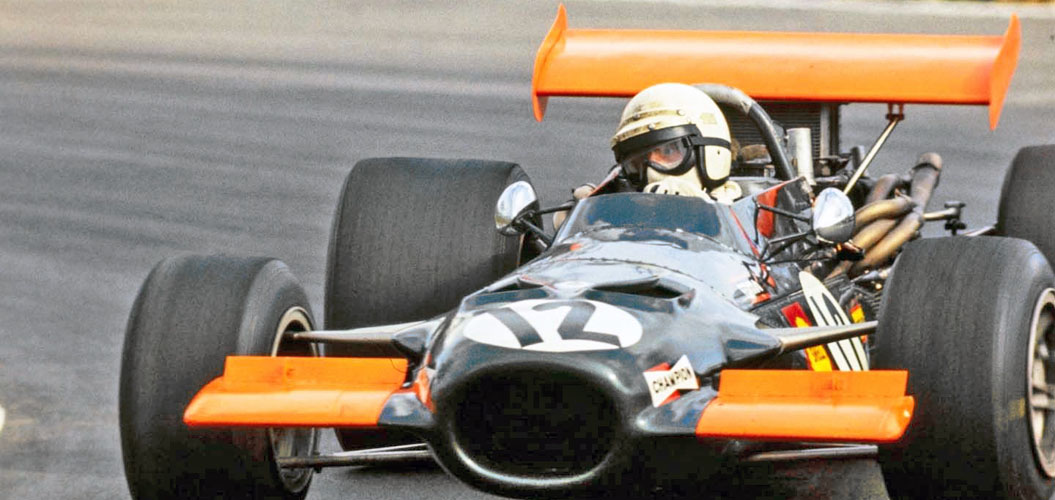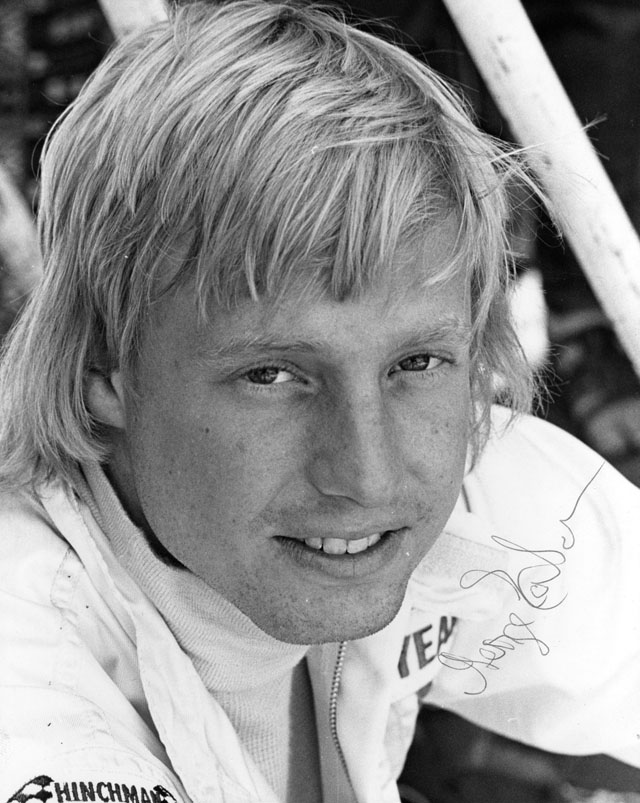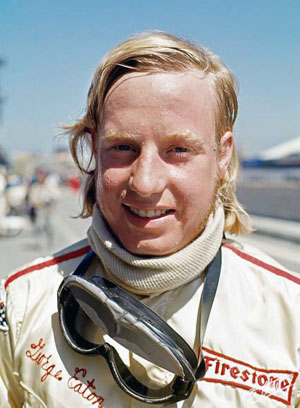George Ross Eaton (born 12 November 1945) is a Canadian former racing driver who is a member of the prominent Eaton family. Info from Wiki
Bio by Stephen Latham
Athough a number of Canadian drivers had competed in F1 before him, including Peter Ryan (1961), Peter Broeker (1963), Eppie Wietzes (1967), Al Pease (3 races between 1967 and 1969), Bill Brack (2 in 1968 and 1969) and John Cordts (1969), George Eaton was that country’s first full-time driver in Formula One. He competed in 13 Grands Prix with BRM, making his debut with two races in 1969 then contested ten events in 1970, starting eight of them, and 1971’s Canadian GP.
The youngest son of John and Signy Eaton of the prominent Eaton family, George Ross Eaton was born on the 12th November 1945 in Toronto, Canada, and would serve as president of the family company for ten years. An interesting sidenote was that his grandfather was the first man in Canada to own a car. He started racing in 1966 with a Shelby Cobra and was second and third at Mosport at the Players 200 and the Dunlop Trophy National races. In July he was second in a BAC Regionals Challenge Cup at Harewood Acres and third the following month at the circuit with a Comstock entered car though failed to qualify for a Can Am event at Mosport in September.
The following year started at the Daytona 24 Hours with a Chevrolet Camaro though he and Craig Fisher retired and after acquiring a McLaren Elva Mark 111 he was thirteenth in the Players 200 Can Am race at Mosport and took second at a BARC Ontario National event at Mosport. Contesting United States Road Racing events in 1968 with the Elva Mark 111 he was ninth in his first race in Mexico City at the end of March. He retired in the following month at Riverside and the Vanderbilt Cup at Bridgehampton though was ninth at St.Jovite and then took third at Watkins Glen in July with his privately entered car (behind Mark Donohue’s Team Penske McLaren M6A and Chuck Parson in Carl Haas Racing’s Lola T70). This was his last outing in the Elva as his following races were in Can Am with a McLaren M1C. His first race in September saw an eighth place finish at Road America though he retired later in the month at Bridgehampton. Then came the Edmonton Speedway Park, in Alberta, which was the only round of the series in Canada that year. In the late 1940s it was a dirt track then in 1967 a drag strip was added and a 4.067 km road course was built, which opened in time for the first Can-Am race this year. For the teams competing, the journey from New York to Edmonton took them 3 1/2 days to trailer the cars to the circuit. George was tenth in this Klondike Trial 200 at Edmonton while in his final races he took third at the Monterey Grand Prix at Laguna Seca (behind John Cannon and Denny Hulme), retired from the LA Times GP at Riverside then seventh in his final race in November’s Stardust GP at Las Vegas.
In 1969 he took a big step up contesting Can Am with a McLaren M12 and Formula A with a McLaren M10A. He also raced in the first two Canadian Formula A/5000 rounds in May. However, although he opened a narrow lead in the Gulf Canadian Road Racing Championship, after finishing second in the Dunlop Challenge Trophy at Mosport and winning at Mont Tremblant he dropped out to focus on the Can-Am series. That year’s Can-Am series was expanded from six events to eleven, with Watkins Glen and Mid-Ohio road courses added plus two super speedways at Michigan and Texas. The season started in June at Mosport (one of three rounds in Canada) and he had a ninth place result with the Chevrolet powered M12 at the Labatt’s Blue Trophy. Later that month he was seventh at the Labatt’s 50 at St.Jovite and in July was fourth at Watkins Glen (behind Bruce McLaren and Denny Hulme’s McLaren M8Bs and Chris Amon’s Ferrari 612 P). The next round at Edmonton, the Klondike 200, saw a three way battle between the two McLarens and Chris Amon’s Ferrari until Bruce McLaren’s engine failed on lap 36. Hulme held on for the win with Amon second and George, running with a flat tyre, came home third ahead of John Surtees in the Chaparral. His next outing was in August at Mid-Ohio’s Buckeye Cup and with the McLarens in the lead the race evolved in a battle for third place with Chris Amon racing strong but John Surtees had to pit with a broken goggle strap and Mark Donohue’s half shaft broke. Just before the end of the race Bruce McLaren pitted, as his oil pressure gauge was registering zero but with only a few laps left he was told to continue. Denny Hulme won the race to take another McLaren 1-2, followed by Chris Amon, Jo Siffert, John Surtees and then George took the sixth place. He suffered retirements with mechanical issues at Road America, the Inver House Scotch GP at Bridgehampton and the LA Times GP at Riverside plus an accident ended his Monterey Castrol GP at Laguna Seca. During this period he was eighth at Michigan while the final round at Reliant Park in Texas saw his best result of the season with second place. At Texas, Mario Andretti took the lead only to suffer a blown engine, as would Amon and Hulme. Bruce McLaren took the win (and the Championship) with George following him home in second place, ahead of Jack Brabham who was making a rare Can-Am appearance. Contesting the SCCA Continental Formula A Championship he was seventh in April with the M10A in his first outing at Riverside then twelfth at the following month’s Monterey GP at Laguna Seca. He qualified fourth but retired at Colorado (due to a water leak) then took another seventh place at Sears Point’s Continental 49er race and his best finish came at Seattle in July when was third, to Eagle Mk5 drivers Tony Adamowicz and Sam Posey. He was fifth in qualifying and finished tenth at the Road America 500 and after qualifying second he came home sixth at the Schaefer GP at Lime Rock. He was thirteenth at Minnesota but did not finish due to transmission problems at the Mosport Continental while back at Lime Rock in September a blown engine meant he did not start the race. At the final round at Mont Tremblant he was fifth in qualifying but retired due to a water leak after seven laps. George was fifth in the final standings, behind Bruce McLaren, Denny Hulme, Chuck Parsons and Jo Siffert though ahead of drivers including Peter Revson, Dan Gurney and Mario Andretti. October that year saw his F1 debut when he was offered drives with BRM in the US and Mexican Grands Prix. Unfortunately he retired the P138 due to engine problems on lap 76 at Watkins Glen then his race in Mexico ended after 6 laps due to gearbox issues.
George continued in Can Am in 1970 plus he was offered a full time contract with BRM by Louis Stanley. However his first race came in the World Sports Prototype Championship in January’s Daytona 24 Hours with a Randy’s Auto Body Shop Lola T70 Mk 111B though he and John Cannon retired without completing a lap due to an oil leak and handling problems. Racing a third BRM that year, he lined up alongside Jackie Oliver and Pedro Rodriguez but it proved to be a disappointing season. The team had acquired sponsorship from Yardley, with the cars featuring a white body with black, gold and ochre stripes in a stylised ‘Y’ wrapping around the bodywork from Spain onwards. His first outing came at Kyalami in March with a P139 (J.Oliver and P.Rodriguez were in P153s) and the car ran in the Owen Racing Organisation’s green colours but he retired on lap 58 with engine problems. There was a second race with the P139 later that month, in the non championship Race of Champions at Brands Hatch, but he retired due to electrical problems while Oliver’s P153 (running in the Yardley livery) retired after 13 laps. Following this he was in a P153 for the rest of the season though he did not qualify in Spain or Monaco. However, the Spanish race was marred by a serious accident involving team mate Oliver and Jacky Ickx’s Ferrari. On the first lap, a failure on the BRM caused him to plough into the Ferrari, puncturing its fuel tanks and the cars became engulfed in flames. Oliver got out quickly but it took Ickx longer and he emerged with his overalls on fire due to being soaked in burning fuel. Disoriented, he ran in search of a marshall and the flames were put out by a soldier. Pedro Rodriguez’s BRM was called in and withdrawn by the team as a precautionary measure, fearing Oliver’s accident had been caused by a recurrence of the front stub axle trouble they had experienced in practice. Despite the blaze, the race continued with cars passing the burning wreckage whilst marshals tried to extinguish the blaze from across the track. He missed Spa due to illness and suffered retirements due to mechanical issues at the Dutch, British and Italian races and did not attend the German GP. His finishes included twelfth place in France and eleventh in Austria then after qualifying eighth at his home race at Mont Tremblant he came home in tenth place but he retired in the season ending US GP at Watkins Glen. Although Pedro Rodriguez won the fourth race of the year, the Belgian GP, taking the team’s first win since 1966, the struggles for the team continued through the year and they eventually finished sixth in the standings.
Alongside the F1 car, designer Tony Southgate was tasked to design a Can-Am car, which would be known as the P154. Although the team usually produced all their own major components, they utilised a big-block Chevrolet V8 engine and a Hewland four-speed gearbox though an engine shop was set up to further develop the engine. The car featured a lightweight fiberglass body and was white with red and green stripes, in deference to the sponsorship from Castrol but when George contested Can-Am with it there were several structural failures and he only finished one race. Over the seasons, McLaren so dominated Can-Am that it was often called the ‘Bruce and Denny show’. In 1967 the team won five of the six rounds (three to D.Hulme and two to B.McLaren) then won every round the next year (D.Hulme winning at Road America, Edmonton and Las Vegas, Mark Donohue at Bridgehampton, John Cannon at Laguna Seca and B.McLaren at Riverside). 1969 was again swept by the team, with B.McLaren winning six races to D.Hulme’s five, and Bruce took the championship by five points. Sadly, in June 1970, Bruce McLaren was killed while testing at Goodwood, with the first race less than two weeks away, and Dan Gurney was asked to fill in with the team. The first round came at Mosport, for the Labatt’s Blue Trophy, with Dan Gurney qualifying on pole and winning the race while George qualified seventh but retired after 33 laps with with oil and transmission problems. The following race at St Jovite saw Dan Gurney again victorious, ahead of Lothar Motschenbacher’s McLaren M8B, with George taking the flag in third place. In two incidents involving the race, Jackie Oliver had a very lucky escape when his car reared up and did a complete back flip before landing and sliding on its nose. Fortunately he was able to walk away from it virtually unscratched. George Follmer had contested the race with a Shadow but it was destroyed afterwards when the trailer carrying it was wrecked by a drunk driver in a stolen car. Unfortunately, there followed a list of mechanical failures for George at Watkins Glen (brakes), the Klondike Trail 200 at Edmonton (wheel bearing), the Buckeye Cup at Mid Ohio (fuel pressure) and Donnybroke (rocker arm after 2 laps). At Road Atlanta, there were a number of retirements during the race and he found himself leading until he eventually had to stop on lap 48 when his engine blew. He did not even start at Road America due to overheating in practice and retired in the final two rounds at Monterey and the LA Times GP at Riverside due to accidents. Despite the poor results in the races, in his defence the car’s handling had been described as ‘terrifying’ though he qualified in the top ten for a number of races, including fifth at Road Atlanta and Donnybrooke, sixth at Edmonton, seventh at Mosport and Riverside plus ninth at St.Jovite and Laguna Seca. His BRM team mate Pedro Rodriguez had contested several Can Am races, with a Porsche 917 at Watkins Glen and a Ferrari 512S at Mid-Ohio and Road America then drove the P154 at the final three races. He was ninth and fifth at Donnybrooke and Laguna Seca then third at Riverside but Tony Southgate told how Pedro visited him to talk about the experience afterwards and told him that ‘in its present form the car was horrible to drive and also was the worst car he’d ever driven.’ Southgate recalled how “that really embarrassed me. He was always so brave and uncomplaining, so it must have been really bad.” Following the disappointing results, the car was reworked with heavily revised aerodynamics for 1971 but George would not be with the team.
In 1971 he had two sports car outings with Ferrari and the North American Racing Team and he was eighth in March at the Sebring 12 Hours alongside Luigi Chinetti Jr in the Ferrari 312 P/71. The next race did not come until June when he made his debut at Le Mans alongside Masten Gregory but after qualifying fifteenth of the fifty-three entrants they retired their 512S due to fuel system problems. Later in the month he co-drove Herbert Muller’s 512M at the Watkins Glen 6 Hours but they retired due to an accident after 17 laps. In September he was invited to drive a P160 BRM in the Canadian GP at Mosport, alongside four other BRMs, driven by Jo Siffert, Peter Gethin, Howden Ganley (though he did not start) and Helmut Marko and George finished fifteenth, in what would be his final F1 race. There were several USAC races in a Fejer Brothers Colt Ford TC and he was ninth on his debut at the Milwaukee 200, then eleventh at the Ontario 500 and tenth in the Trenton 300. He contested the final round at Phoenix Raceway in CHEK Racing’s Lola Ford TC but retired with a mechanical problem. There was also one entry into a NASCAR Grand National Series event at Charlotte Motor Speedway but he failed to qualify.
George only entered two events in 1972 and he was reunited with Luigi Chinetti Jr and NART at the Daytona 24 Hours though they did not finish due to a holed fuel tank after 7 laps. In the following month he contested another USAC race with the Fejer Brothers’s Colt Foyt TC and was eleventh at the Phoenix 150. He retired from racing that year and later became involved in philanthropic causes, serving on the board of the Toronto General and Western Hospital Foundation and also as a trustee on the John David and Signy Eaton Charitable Foundation. He was inducted into the Canadian Motorsport Hall of Fame in 1994 and in 1996 received an honorary Doctor of Law degree from St Francis Xavier University.








